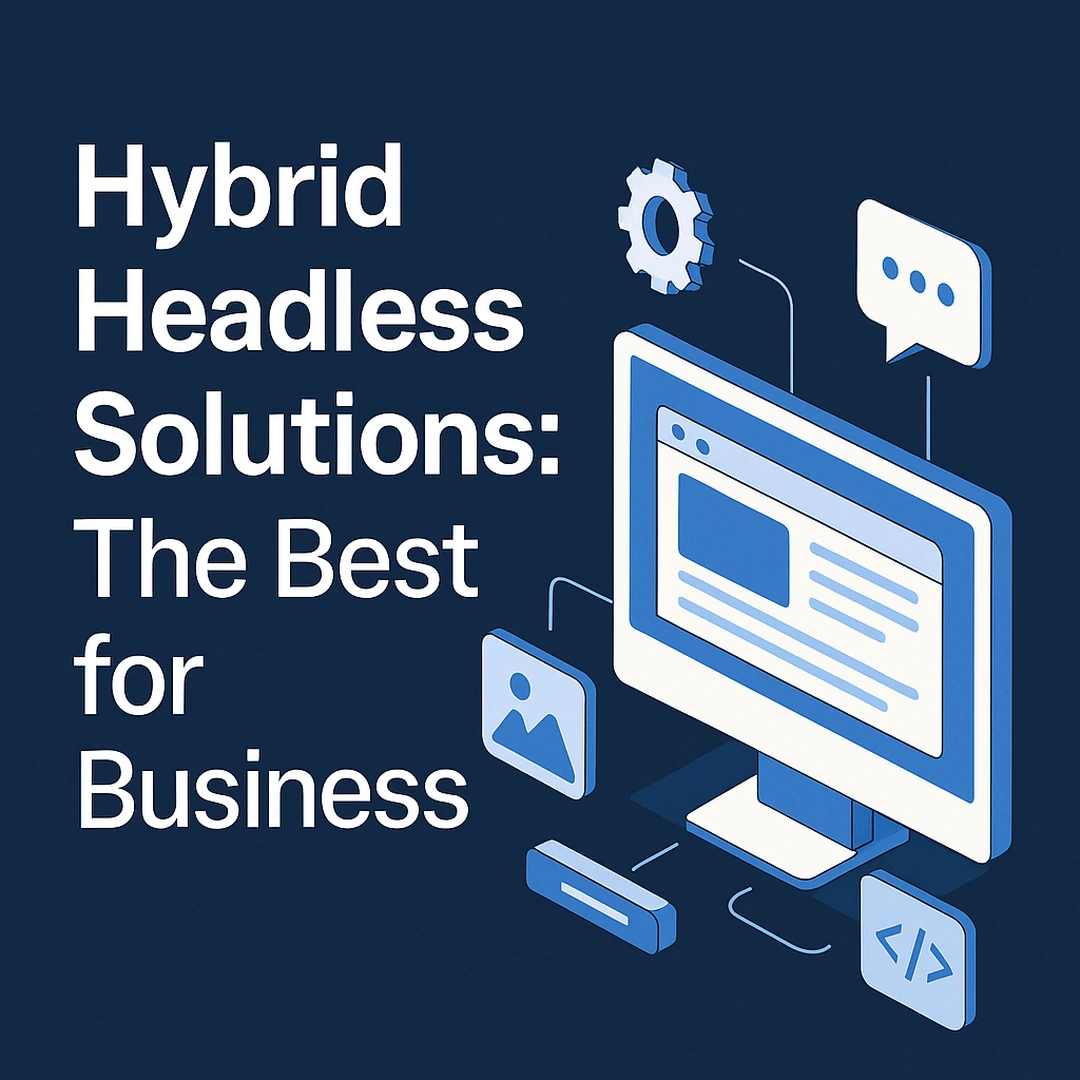Get your free consultation today!
Share with your Colleagues
Categories
ROI Calculator
Moonstone Interactive is the only San Francisco Bay Area web design firm and Internet Marketing expert that offers a free online ROI Calculator
Author: Steve Herz

Table of Contents
- What is a Digital Experience Platform?
- What are the features of a Digital Experience Platform
- Why Businesses Need Digital Experience Platforms
- Why Optimizely or Kentico?
- How Moonstone Interactive Can Help
- FAQs About Digital Experience Platforms
Does it feel like your brand is scattered across the web—your website says one thing, your app another, and social media is a whole different story?
Keeping everything aligned is tough, especially when customers expect a smooth, consistent experience no matter where they find you. That's where things can get tricky.
But here's the good news: a Digital Experience Platform (DXP) can bring it all together, ensuring every interaction with your brand feels seamless and personalized.
What is a DXP exactly? How can it help you optimize the entire customer journey across all platforms? In this guide, we'll answer these questions and provide more details about DXPs and all their moving parts.
What is a Digital Experience Platform?
A Digital Experience Platform, or DXP, is software that helps businesses manage all their digital channels, like websites, apps, and social media, in a way that keeps everything working together seamlessly.
The goal is to ensure that people get a consistent and personalized experience no matter where they interact with your brand.
Essentially, it's a system that connects everything online, so customers have a smooth experience, no matter where they engage with your business.
DXP vs. CMS vs. WMS
Content Management Systems (CMS) and Web Management Systems (WMS) were the go-to solutions for managing online content and websites.
Many businesses use a content management system to create and publish website content. It was a must-have. The system handled everything from blog posts to product pages, making it easy to keep a website updated.
However, a CMS primarily focuses on just the website, which means it does not do much to help with other digital channels like mobile apps or social media.
Web management systems came along and offered a bit more. They handled content, as well as the structure, performance, and security of websites. But even then, they were mainly about the website and didn't extend beyond that.
That's where a digital experience platform comes into play. Unlike CMS and WMS, which were excellent in their time but limited to certain areas, a DXP manages the entire digital experience across all platforms.
Whether it's your website, mobile apps, or social media, a DXP connects everything, giving customers a consistent and personalized experience regardless where they engage with your brand.
That's why it's a better choice for today's businesses looking to create a cohesive digital experience.
Types of Digital Experience Platforms
DXPs come in different varieties, each suited to specific needs:
- CMS DXP: Consider this an upgrade to the traditional CMS. It adds cool features like personalization and better integration with other tools. If you want to manage content across multiple platforms and offer a more personalized experience, a CMS DXP is a significant next step.
- Portal DXP: This type is about creating personalized portals for specific groups—customers, employees, or partners. It's perfect for businesses that must provide tailored experiences based on who's logging in.
- Commercial DXP: Geared toward e-commerce, a Commercial DXP is about making the shopping experience as smooth as possible. From browsing to checkout, these platforms integrate everything to ensure customers have a hassle-free experience.
What Are the Features of a Digital Experience Platform?
Now that all the basics are out of the way, let's get into the nitty gritty: the essential features of a digital experience platform:
1. Content Management
At the heart of a DXP is content management. It lets you create, manage, and publish content across all your digital touchpoints.
The key is consistency. However your customers interact with your brand, they should get the same message and tone.
A DXP's robust content management capabilities make it incredibly easy to keep your content up-to-date and aligned with your overall strategy, so managing content across different platforms feels like a breeze.
2. Personalization
One of the most incredible features of a DXP is how it personalizes the user experience. By tapping into data on customer behavior, preferences, and interactions, a DXP tailors content to fit each person's specific needs and interests.
So, when someone interacts with your brand, they get a unique experience that feels more relevant to them.
Personalization like this is vital to building stronger connections with your audience while meeting customer expectations, and a DXP makes it happen on a large scale.
3. Integration
A DXP isn't just about content management; it's also about connecting all the digital tools and systems your business uses.
Integration is a big part of what makes a DXP powerful. It works seamlessly with your CRM, e-commerce platforms, marketing tools, and more. It means all your digital assets work harmoniously to have a unified and efficient digital experience.
Instead of dealing with many fragmented systems, a DXP pulls everything together, making it easier to manage and optimize your digital presence.
4. Analytics and Actionable Insights
You must understand how customers interact with your digital channels to make intelligent decisions.
A DXP provides analytics tools that help you track user behavior, measure how well your content is performing, and figure out what's working and what's not.
With this data at your fingertips, you can keep fine-tuning the customer experience, making adjustments based on real-time feedback and trends.
For example, imagine seeing a spike in traffic to your new landing page, but conversions aren't following suit.
With a DXP's analytics, you can dive into the details—maybe users are getting stuck on a form that's too long, or the call-to-action isn't clear enough. By pinpointing these issues, you can make immediate fixes.

5. Omnichannel Support
Customers interact with brands across multiple platforms—websites, apps, social media, Internet of Things (IoT) devices. A DXP's omnichannel support ensures the experience is consistent and connected across all these touchpoints.
A DXP's omnichannel support ensures the experience is consistent and connected across all these touchpoints.
Whether someone is browsing your website, using your app, or engaging with you on social media, a DXP makes sure the experience feels seamless.
This consistency is necessary for building trust and loyalty, as it shows customers that you deliver a unified brand experience no matter where they engage with you.
6. Customer Data Management
A DXP also handles customer data management, which collects, organizes, and uses customer information effectively. It's a one-stop shop for all the data you gather from different touchpoints.
With everything stored in one place, creating personalized experiences for your customers is much easier. Having a centralized view of customer data means getting to know your audience and tailoring your interactions to meet their needs.
7. Workflow Management
Workflow management is another essential piece of the DXP puzzle. It's there to help you simplify and automate your business processes so everything runs smoothly.
With this feature, you can define, monitor, and optimize all the steps in creating and managing digital content. It ensures your team works efficiently, follows consistent procedures, and hits those deadlines.
Why Businesses Need Digital Experience Platforms
Customer expectations are higher than ever. They expect seamless, personalized digital customer experiences across all the channels they interact with, which is precisely why a DXP is more of a must-have than a nice-to-have.
Let's take a look at the most important benefits of using a DXP:
Consistency Across Channels
You know how we're all hopping between different platforms—websites, apps, social media—all day? As we've repeatedly mentioned, customers expect the same smooth experience no matter where they interact with your brand.
A DXP helps keep the customer journey consistent across the board. Whether someone's on your website or scrolling through your Instagram, the messaging, tone, and overall vibe should feel the same.
This consistency helps build trust and keeps people coming back because they know what to expect from your brand, no matter where they find you.
Personalization at Scale
These days, people want things to feel personal—they don't want to be just another number.
A DXP lets you deliver personalized content and experiences to every customer, and it can do this on a big scale. With the data you've got on how people behave and what they like, a DXP tailors the experience for each person.
It allows you to give everyone their custom version of your brand, making them feel special and more likely to engage with what you're offering.
Improved Efficiency
Managing your brand's digital presence across different platforms can feel like juggling a million things simultaneously. A DXP simplifies that by bringing everything together in one place.
It handles content creation, customer data, analytics—you name it. This way, you're not spreading yourself thin trying to keep up with everything separately.
It saves time, reduces headaches, and lets you focus on what matters: delivering great content and experiences to your audience.

Data-Driven Decisions
One of the best things about a DXP is the analytics it gives you. You get all these insights into how people interact with your digital stuff—like what's working, what's not, and where you can improve.
With this data, you can make smarter decisions and adjust your strategies to keep up with user expectations.
You notice through your DXP's analytics that many visitors leave your website on a particular product page. With that insight, you can dig into what's causing the drop-off—maybe the page loads slowly, or the information isn't clear enough.
Armed with this data, you can make adjustments, like optimizing the page speed or reworking the content, to engage visitors and improve your conversion rates.
Scalability
As your business grows, so do your digital needs. A DXP will grow with you.
Whether you're getting more traffic, adding new products, or expanding into new markets, a DXP can handle it without breaking a sweat. The DXP will scale so your digital experience can keep up as your business grows.
Improved Collaboration
Another great thing about a DXP is how it helps your teams work better together. Since everything's in one place, it's easier for marketing, sales, IT, and customer service to stay on the same page.
Communication is smooth, approvals happen faster, and everyone's working towards the same goal. This kind of collaboration means things get done quicker and more effectively, which is a win for everyone.
Better Customer Retention
Customers who have a great experience with your brand — consistent, personalized, and seamless — are more likely to stick around.
A DXP helps you build these long-term relationships by ensuring every interaction is spot on. Happy customers are loyal customers; over time, this loyalty turns into repeat business and positive word-of-mouth. A loyal customer base is one of your brand's best assets.
Competitive Advantage
Standing out in today's market isn't easy. But with a DXP, you've got a serious competitive edge.
It lets you deliver better digital experiences than your competitors, adapt quickly to new trends, and meet customer demands in ways others might struggle with. Innovating and providing top-notch experiences puts you ahead of the game. It helps solidify your brand as a leader in your industry.
Why Optimizely or Kentico?
Optimizely DXP and Kentico Xperience are powerful tools for businesses that want to level up their digital presence. You are in good hands with Moonstone Interactive as an Optimizely Content Cloud Certified Solution Provider and a Kentico Xperience Certified Solution Provider.
Gartner and Forrester regard Optimizely and Kentico as leading DXP platforms in the industry. They have similar features with different advantages. Moonstone will help you select the best platform to fulfill your business goals and marketing strategies.
The main difference is that larger enterprises typically prefer Optimizely for its advanced dynamic scalability. In contrast, middle-market enterprises prefer Kentico, which has built-in web parts that accelerate implementation.
Here's how these DXP platforms can help you undergo that digital transformation you're aiming for:
Easy Content Creation and Management
Optimizely DXP and Kentico Xperience make creating and managing content super simple. With its drag-and-drop interface, you can easily upload, schedule, and organize your content—no coding skills needed.
Plus, with version control, you can keep track of changes and revert if necessary.
Personalization and Targeting
Optimizely's and Kentico's personalization features are the best, given their AI capabilities. You can customize content for different audience segments based on behavior or location, which helps ensure every visitor gets a relevant and engaging experience.
E-commerce Integration
Optimizely's and Kentico's integrated e-commerce tools are a big plus for running an online store. From product management to order processing and payment handling, These e-commerce tools help run your store so you can focus on growing your business.
SEO and Marketing Tools
Optimizely and Kentico have built-in SEO features like customizable URLs and meta tags that make ranking your content well in search engines easier.
Combine that with marketing tools like A/B testing and automated campaigns; you've got everything you need to reach the right audience effectively.
Multi-Channel and Multi-Language Support
These DXPs ensure your content looks great and works well across all devices and platforms.
And suppose you're reaching a global audience. In that case, its multi-language support makes connecting with customers in their preferred language easy.
Robust Security and Scalability
Security is a big deal with Optimizely and Kentico. They offer role-based access, SSL support, and compliance with data protection regulations.
Plus, as your business grows, Optimizely and Kentico scale with you, ensuring top performance even as traffic increases.
Analytics and Integration
Optimizely and Kentico give you valuable insights with analytics and reporting tools, helping you understand user behavior and content performance. It also integrates smoothly with other tools like CRM systems and marketing platforms, which helps make your digital strategies even more efficient.
How Moonstone Interactive Can Help
Picture this: trying to manage your website, apps, and social media without a system to connect them all. It's like juggling too many balls—eventually, something will drop.
Without a good DXP, keeping everything consistent and personalized across channels becomes a major headache. Content gets outdated, customer experiences feel disconnected, and your brand takes a hit.
That's where a DXP like Optimizely and Kentico come in. It ties everything together so that your digital channels work harmoniously, providing customers with a seamless, personalized experience. And, with Moonstone Interactive's expertise, they can unlock Optimizely's or Kentico's full potential.
Are you tired of the chaos? Contact Moonstone Interactive today for a free consultation. Let's discuss how Optimizely DXP or Kentico Xperience can simplify your digital presence and keep your customers returning for more.
Moonstone Interactive is a certified developer for two industry-renowned DXP platforms: Kentico Xperience and Optimizely DXP. Contact Moonstone today for a free consultation!
FAQs About Digital Experience Platforms
What's the main difference between a DXP and a CMS?
A CMS primarily focuses on managing content, while a DXP goes beyond that, integrating various online channels and digital tools to provide a seamless experience across all touchpoints.
Do I need technical expertise to use a DXP?
Not necessarily. While some DXPs might require a bit of technical know-how, many, like Optimizely, are designed to be user-friendly and accessible to non-techies.
How does a DXP improve customer experience?
Integrating all digital channels and using data to personalize interactions, a DXP helps ensure customers have a consistent and engaging experience, no matter where they interact with your brand.
Is it worth the investment?
For businesses serious about improving their digital presence and customer experience, a DXP is worth the investment. The benefits of efficiency, personalization, and customer satisfaction often outweigh the costs. However, remember that you must also reform your business practices for a DXP to be effective.
.webp?ext=.webp)

